Skyactiv engulfs new Mazda CX-5

CX-5 styling strategy was done to encase Mazda's Skyactiv engine, drivetrain, aero and design technology.
By John Gilbert
Mazda has established a reputation for building vehicles that range from unusual to mainstream, with all of them sharing a heritage of being enjoyable to drive. With its new CX-5, Mazda may have outdone even its own standards — and the analogy of hitting a home run is noteworthy when nearly all competitors are settling for doubles and triples.
The CX-5 meets the demands of consumers in a struggling economy, who are seeking the seemingly impossible combination of efficient size, cutting-edge technology, safety, fun to drive performance and handling agility, high fuel-economy potential, and high-quality features, while still being available at a reasonable price. After a brief preliminary drive at its introduction, the CX-5 gave no hint of a weakness in any of those categories, all for a price structure starting at $21,000.
Skyactiv was impressive when first unveiled in the Mazda3 in October, although we were told at the time it had to be limited in its totally holistic application, because the full “spaghetti pile” of exhaust manifolds would not fit in the engine bay, and must wait for the next generation Mazda3. It was still an impressive jump, but now we learn the true difference. The CX-5 is the first of what Mazda calls its sixth generation of design concepts, and it was designed to be all-around Skyactiv to house the engine and transmission. The huge manifold fits under the hood, and it gains enough added torque to — suprisingly — outperform the smaller and lighter Mazda3.
Mazda introduced the CX-5 to the auto media at Monterey, Calif., so that we could drive it on Mazda Raceway at Laguna Seca. Driving an SUV, even a compact crossover SUV, on a famous road-racing circuit is a bold venture, but even in a steady rainstorm, the results were impressive. We were advised to stay off the fastest racing line, because the rain would make it slick, but after driving both the front-wheel and all-wheel-drive models for several turns, I felt confident enough to first go through the fast line at every turn, and then go hard through them all. The CX-5 never varied, never leaned, and never threatened to break traction.
It was so good that I asked a top Mazda performance engineer about the difference in lap time between the admittedly quick Mazda3 Skyactiv and the new CX-5 around the twisting Laguna track. He said the difference was 3 seconds — in favor of the CX-5! In road-racing, lap times are differentiated by tenths, and even hundredths, so a difference of 3 seconds a lap might cause the runner-up to withdraw.
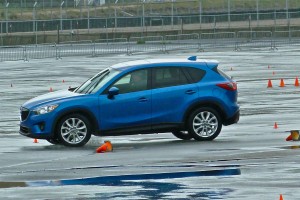
When pushed around a race track, or splashing around an autocross in the rain, the CX-5 was stable and firm.
We later pushed the CX-5s around a well-designed autocross course set up in the puddles of the paddock parking lot. Again, starting cautiously you realized you could take every turn faster, and confidence built quickly.
And this from a CX-5 that has highway fuel economy numbers ranging from 31-35 miles per gallon, depending on the model. My driving partner and I recorded a computerized 31.5 mpg on a stretch where my driving intentions were to evaluate the suspension and agility on the rolling hills and curving roadways inland from Monterey.
The shift from large SUVs to smaller and more fuel-efficient crossovers means manufacturers from all around the world are scurrying to improve their smallest SUVs to grab a slice of the expanding pie. A lot of outstanding vehicles crowd the compact crossover segment, but the common theme is compromise. In seeking more power, sportier handling, more comfortable suspension, interior amenities, safety, and improved real-world fuel-efficiency, providing “most of the above” is commendable. The Mazda CX-5 boasts “all of the above.”
The secret is not the CX-5’s design, or interior, or fun-to-drive suspension — although all of those elements are there — but the all-encompassing assets of Mazda’s new Skyactiv concept with its very impressive Skyactiv engine and purpose-built transmission. Read more
Fiat Abarth: ‘right amount of wrong’
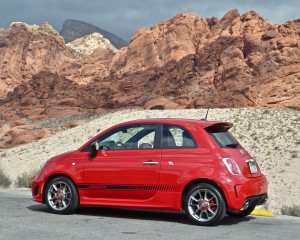
Stretched longer and housing power, suspension, interior and exterior upgrades, the Fiat Abarth costs $22,000.
By John Gilbert
Advertising can be coersive, exaggerated, informative, and meaningful, sometimes just annoying, other times fun. Then there are those special cases, where an ad can be so memorable it could only be improved if you could bring it to real life.
Fiat has pulled off one of those special ads, and it started with the Super Bowl and carried through to the introduction of the 2013 Fiat Abarth at the car’s introduction, in Las Vegas in early March. Fiat started to bring its subcompact 500 into the U.S. a year ago, and Jennifer Lopez did a series of memorable commercials driving the 500, but the little car drew some, but not a lot, of interest. Then came the Super Bowl.
The Fiat Abarth is a specially modified and turbocharged version of the new little subcompact 500 coupe, adding a new dimension to the 500 for Fiat, Italy’s expansive and technically savvy company, which now owns Chrysler Group. “The 500 is a fun, unique, agile, and cute car,” said Tim Kuniskis, the head of Fiat North America. “The Abarth is a 500 with just the right amount of wrong…It’s flirting with irrational, for $22,000.”
It’s not at all irrational if you thought the Fiat 500 needed a little extra dose of punch, because the Abarth has enough punch to satisfy discriminating performance-oriented drivers, whether on their daily commute, roaming on your favorite twisty roads, or taking advantage of a track-day at a local road-racing circuit. The question was, how to translate the special qualities of the Fiat Abarth, combining its practical side with its exotic Italian passionate heartbeat.
That made the Super Bowl the perfect launching pad for the Fiat Abarth, and it was a provocative ad that has continued, after turning out better than anyone could have imagined. The car comes in different colors, but because of the ad, you’ll have reason to picture it mainly in black.
As always, the Super Bowl was loaded with clever commercials, and sometimes they’re better than the actual football game. If you were normal — or at least a normal, red-blooded male — you undoubtedly remember the commercial where a normal-looking fellow is walking down a busy sidewalk, New York we’d guess, carrying a cappucino, or latte, or mocha, or some such designer coffee he has just purchased. Suddenly he stops in his tracks and stares, because ahead of him, bending over to adjust her high heels, is a stunningly beautiful, dark-haired woman in a provocatively flowing black dress with red trim. She glances back and catches him staring at her, and he freezes. She straightens up and confronts him, slaps him across the face, grabs him by the necktie and pulls him close to her. She reaches into his mocha-latte-cappucino thing and scoops out a fingerful of whipped cream. She puts it into her mouth, but a small bit of it falls, strategically plopping right where her discreetly plunging neckline is most discreet.

Catrinel Manghia repeated her prize-winning performance on Fiat Abarth TV ads at the Las Vegas media introduction. The car looked good, too.
The totally smitten guy is somewhere between shock and ecstacy, as he leans forward, slowly, eyes closed. We think he might attempt to lick up the fallen whipped cream, but as he leans forward, he opens his eyes to find that the most beautiful woman in the world has vanished. In place of his passionate objective is a new passionate objective — a Fiat Abarth, parked at the curb and wearing color-coordinated black paint with red accents.
When the seductive commercial first ran during the Super Bowl, Fiat’s website went instantly crazy. According to Edmunds.com, a widely accepted automotive news website, the Fiat showed an immediate increase of 3,354 percent in inquiries immediately after the Super Bowl ad aired — the largest increase of any of the many cars advertised during the game. Virtually all the hits were for the Fiat Abarth.
Since the Super Bowl, Fiat’s website has registered 8 million hits for the Abarth on Youtube, said Kuniskis, speaking at the news media introduction for the Fiat Abarth, in Las Vegas in early March. There have been more online requests for the Fiat Abarth since the Super Bowl than there had been, total, for the 500 itself in a full year. Read more
Fighting Sioux win 3rd straight playoff title
By John Gilbert
SAINT PAUL, MN. — If it was the last time the North Dakota hockey team ever wears the familiar green jerseys with the stylish Native American warrior on the chest, the Fighting Sioux gave the controversial logo and nickname a proper sendoff Saturday night, before 16,838 observers at Xcel Energy Center — whipping Denver 4-0 in the WCHA Red Baron Final Five championship game.
North Dakota thus claimed the Broadmoor Trophy for an unprecedented third consecutive time, and gave Aaron Dell an easy shutout for his third victory in three days. The Sioux (25-12-3) ride into next week’s NCAA tournament on the wings of a seven-game winning streak, which started, ironically, after a 5-3 loss that resulted in a split at Denver. They could, in fact, return to Xcel Center as the No. 1 seed of the West Regional, when pairings are announced Sunday.
However, wherever they go, it will be clad in new North Dakota jerseys, because the NCAA has decreed that if North Dakota insists on wearing its Fighting Sioux-logo jerseys, or uses the Fighting Sioux nickname, they will forfeit any NCAA victories.
North Dakota’s old Fighting Sioux jerseys worked just fine to stop Denver (24-13-4). The Pioneers were outshot 29-22 and unable to muster any sustained offense, while the Fighting Sioux got a goal and an assist from both Carter Rowney and Mark MacMillan, and added power-play goals from Brock Nelson — his fourth in three Final Five games — and Michael Parks.
It used to be customary that teams that had to win a play-in game to reach the semifinals would never have enough staying power to win three games in three days, but Minnesota-Duluth pulled it off in 2009, and North Dakota won three in 2010. This year, however, was the first in which both finalists were playing for the third time in three days.
Denver has had a rougher road, playing the sixth game in nine days. First, the Pioneers had to go three games to beat Wisconsin, losing 1-0 and winning 3-1 and then 3-2 in overtime to get to Xcel Center. After three days of rest, the Pioneers had to go overtime again to beat Michigan Tech 3-2 Thursday, then beat UMD 4-3 in two overtimes Friday in the longest game in Final Five history. If six games in nine days wasn’t enough, they included four overtime periods, the equivalent of another full game, making it more like seven games in nine days.
North Dakota beat St. Cloud State 4-1 on Thursday, and though the Sioux seemed tired as they fell behind 3-0 through the first half of its semifinal against Minnesota Friday, before rallying to win 6-3. Maybe there was a positive carryover from scoring six unanswered goals against the Golden Gophers.
“We wanted to play a complete game tonight,” said North Dakota coach Dave Hakstol. “We didn’t play complete games either Thursday or Friday, and we wanted to exploit the chance they might be a little more tired, because of how much they’ve had to play. Our energy level was pretty good, and we were plus-one 5-on-5, scored two power-play goals, and one short-handed.”
It appeared that the Pioneers may have finally been overtaken by battle-fatigue, and it didn’t help their manpower when they lost defenseman Josiah Didier to an injury, then offensive star Jason Zucker went out in the third period and was taken to a hospital for an MRI on an “upper body” injury. At one point coach George Gwozdecky said he moved two forwards back to play defense. “I noticed how much quicker we were able to go back and get the puck,” Gwozdecky said. “That made me realize how tired we were.”
Gwozdecky praised North Dakota for its play, however. “North Dakota was sharp and moved the puck well,” he said. “The way they played last night with their great comeback, and the way they played tonight, I would say they would be a very likely Frozen Four team.”
Goaltender Aaron Dell was sharp in his third game in three days, which, he said, he hadn’t done since his junior hockey days in the Alberta league. The Pioneers had the first great scoring chance, but Dell came up with the save when Nate Dewhurst blasted a one-timer from the slot after a feed from behind the net. Later, Dell said that was the toughest save he could remember. “The guys made it pretty easy for me,” he said.
Denver went back to goaltender Juho Olkinuora, who won against Tech, after Sam Brittain made a tournament record 67 stops against UMD.
A few seconds after Dell’s big save, Mario Lamoureux wound up to shoot at the other end. Denver freshman Matt Tabrum hooked his stick to prevent a shot, and was called for hooking at 16:25, and North Dakota jumped at the power-play chance. Corban Knight pulled a left-corner faceoff back to Dillon Simpson, who shot from the top of the circle. The blocked shot popped up into Brock Nelson’s body, and he let the puck drop, then scored his 27th goal of a sterling sophomore season into the Denver net at 17:43.
“Knighter made a big play winning the faceoff, and when Dillon shot the puck bounced up off the goalie and hilt me,” said Nelson. “I was just lucky to be in the right place, and I got a good stick on it.”
On the next shift, North Dakota center Carter Rowney skated to the left edge as Mike MacMillan sent him a perfect pass for a goal at 18:29, and the two goals in 46 seconds sent the Fighting Sioux into intermission up 2-0.
“They started off better than we did, and they kept it rolling,” said Denver center Drew Shore. “We don’t play three games in a row much, but the first goal in any game is huge. They got it, and I thought that was one of the big turning points.”
True, if both teams were weary, the first goal could provide an adrenaline jump-start, and the Fighting Sioux kept feeding it. Early in the second period, they were bolstered by two Denver penalties, and on the second of those, Michael Parks scored a power-play goal with a quick shot from deep on the right side at 9:58.
To that point, the Fighting Sioux hadn’t drawn a single penalty, but they got the next three. Rowney’s second penalty in a row opened the third period, but instead of giving hope to the Pioneers it was the Sioux who scored, short-handed. MacMillan blocked the puck free from a Denver skater at center ice and raced in alone at Olkinuora and drilled a shot into the left edge at 7:11.
A goal at 7:11, short-handed at that, for a team wearing green uniforms on St. Patrick’s Day in downtown Saint Paul — how could the Pioneers overcome that?
They couldn’t. About the only highlight for Denver in the third period was when Brock Nelson fired the rebound of Danny Kristo’s shot into the net, the officials reviewed it and disallowed the goal before Kristo had skated into the goal crease and bumped relief goalie Adam Murray an instant before the puck crossed the goal line.
Gwozdecky said, “We are really looking for a little rest. Whatever region we’re in, great. We just need some rest, and maybe we could even get a couple of our long-term injured players back.”
Sioux second-half surge sinks Gophers 6-3
By John Gilbert
SAINT PAUL, MN. — The first semifinal set Red Baron Final Five records for length of time, and saves, but the second semifinal provided an even more remarkable turnabout, as North Dakota spotted top-seeded Minnesota a 3-0 lead, then the Fighting Sioux stormed back for six unanswered goals to stun the Golden Gophers 6-3 in front of an Xcel Energy Center crowd of 16,738.
The game was amazingly split exactly in half, as the Gophers led 3-0 at the halfway point, and the Fighting Sioux simply took the game over, gaining momentum with every goal. North Dakota (24-12-3) roars into Saturday night’s WCHA playoff final against Denver, which beat Minnesota-Duluth 4-3 in double overtime after blowing a 3-0 lead. It means that this year’s champion will have won three games in three days.
“We’ve had a lot of comebacks,” said Mario Lamoureux, the Sioux captain and third line center, who scored two goals in the third-period onslaught. “But I’ve never been part of a game where it was completely dominated one way, then the other.”
As if carrying out the exact opposite of the first game, Minnesota (26-13-1) was rested and ready with the bye, and owned all the plays and the momentum, aided by all three power plays in the first period, when the Golden Gophers outshot North Dakota 12-2. On the second of those power plays, Gopher freshman Kyle Rau scored his 17th goal of the season as he hurtled over goaltender Aaron Dell while scoring for a 1-0 lead.
In the second period, Erik Haula shot from center point and Jake Hansen deflected it in for another power-play goal, at 5:55, to make it 2-0. And at 10:01 — the midpoint of the middle period — Zach Budish deflected in Justin Holl’s pass from wide to the right of the net, and the Gophers were cruising at 3-0.
“We played some of the best hockey we’ve played and jumped off to a 3-0 lead,” said Hansen. “They got one goal, and I think we were scared of losing. We were outshooting them something like 23-8, but after they scored, we played horribly. We went away from our system, and we played really sloppy and they took the momentum.
“It went from 3-0 to 3-3, but we’ve got to keep fighting. We just didn’t have it in us tonight. I think we were more shell-shocked than anything.”
With 5:31 left in the second period, North Dakota coach Dave Hakstol called a time out. It didn’t seem as though any words could make a difference, because Minnesota seemed to be in complete control. “Nothing special was said,” Hakstol said. “We had tired bodies on the ice, and we had iced the puck, so we couldn’t change. We had absolutely no gas in the tank in the first half of the game.”
But from then on, it was all North Dakota.
Derek Forbort, a sophomore defenseman for North Dakota, flung a deflected shot from the right point that eluded Gopher goaltender Kent Patterson at 14:51, giving the Sioux their first sign of life, but at 3-1, the third period started with no illusions for the Sioux, who were being outshot 23-11 at that point. Incredibly, North Dakota started rolling in the third period and not only pumped five more goals, but outshot the Gophers 17-2.
“We knew we had to regroup,” said Lamoureux. “We just got going, rolled with the momentum, and the game became fun.”
There was still some catching up to do. At 5:31 of the third, Michael Parks went to the net and had a pass deflect in off his skate to cut it to 3-2. “I went hard to the net, and the puck bounced off me somewhere,” said Parks.
Exactly 30 seconds later, Brock Nelson blocked a high bouncing puck and fired it in to tie the game 3-3. The large contingent of Fighting Sioux fans in the crowd went crazy, and the Sioux poured it on. Patterson in goal for the Gophers was like a young man caught at the base of an avalanche coming down upon him.
Lamoureux, who had exactly one goal all season but willingly played his leadership role to the hilt, scored at 9:42 to lift the Fighting Sioux to their first lead of the night at 4-3. Minnesota, which hadn’t drawn a single penalty, got one then, at 9:56, and Corban Knight scored at 10:19, on North Dakota’s only power-play chance, to make it 5-3.
Minnesota coach Don Lucia was asked if he considered taking a time out and he said: “I don’t know if it would have done any good.”
Lamoureux scored again by rushing up the right side, sending a hard backhand pass across the slot to Mark MacMillan, then going to the net and jamming in the rebound at 16:10. He now has three goals for the season.
Goaltender Aaron Dell, who looked helpless in the first half of the game, never allowed another goal, and the Fighting Sioux stormed into the championship game.
“We had great energy and a very good first period,” said Lucia. “Congratulations to North Dakota, because we couldn’t get it back going. We’ve been very good in the third period all season — we’ve only allowed 18 goals total in the third period. And we gave up five tonight. We punched, they punched back, and we wilted.”
Denver blows 3-0 lead, tops UMD in 2 OTs
By John Gilbert
SAINT PAUL, MN. — Zac Larraza is a Denver freshman from Scottsdale, Ariz., whose most prominent role in Friday’s first semifinal at the WCHA Final Five was to serve a major penalty for Denver teammate Larkin Jacobson. Until the second 20-minute overtime, that is. Then, after both teams had played to exhaustion in the longest game in WCHA playoff history, Larraza got on the Xcel Energy Center ice and scored his first collegiate goal to send the Pioneers into the playoff final with a 4-3 victory over Minnesota-Duluth.
The play started as a rush by Denver’s fourth line, and freshman center Matt Tabrum fired a shot from the right side that glanced off the right pipe and out toward the blue line. Defenseman John Ryder shot again.
“Ryder threw it at the net and it hit me in the chest,” said Larraza, who let the puck drop in front of him, pulled it to his right as goaltender Kenny Reiter went down, and then flicked a backhander into the open goal. He did it with the poise and certainty that a veteran scorer might have shown. Instead, Larraza was dressed as Denver’s 13th forward — a spare after the four regular lines.
“That was the biggest goal I’ve scored,” said Larraza. To say nothing of the only one. “I got about 10 shifts in the game, so I was still fresh at the end.”
Officially, the goal came at 8:14 of the second 20-minute overtime, which means it was after 38:14 of sudden-death play, making the game’s duration 98 minutes, 14 seconds, breaking the league playoff record, and leaving 12,804 fans nearly as drained as the players. Another record set in the game was the 67 saves by Denver goaltender Sam Brittain, who withstood UMD’s determined comeback from a 3-0 deficit, which featured the Bulldogs outshooting Denver 70-49.
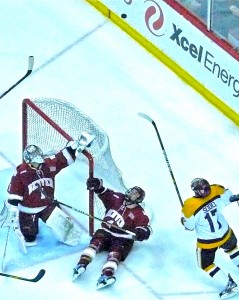
Goalie Sam Brittain, defenseman Josiah Diddier, and UMD's Mike Seidel watched the bouncing puck's trajectory.
The victory sends Denver (25-12-4) into Saturday’s championship game against the winner of Friday night’s Minnesota-North Dakota second semifinal. UMD goes home 24-9-6, but certain to have a high seed in next week’s NCAA tournament field.
“We dug ourselves a hole at the start, but we did a lot of good things in the second half of the game, and it became a helluva hockey game,” said UMD coach Scott Sandelin. “Both teams had a lot of chances and both goalies made some tremendous saves.”
UMD, which lost a first-round Final Five game to Bemidji State a year ago, before catching a hot streak that went all the way to the NCAA championship on the same Xcel Center ice, had a first-round bye this time as league runner-up, but all that got the Bulldogs was the challenge of playing catch-up against preseason WCHA favorite Denver, the league’s third-place finisher.
As often happens in the Final Five, teams resting with first-game byes don’t always have a big advantage in the semifinals, because during the long season of two-game series, many teams play better in the second game. That theory seemed at work, as Denver, which had to beat Michigan Tech 3-2 in overtime on Thursday to reach Friday’s semifinals, gained the early advantage and built on it during the first period and a half.
The Pioneers led 1-0 on Shawn Ostrow’s first-period goal, when the junior center rushed up the left side 2-on-1 and sent a perfect shot into the upper right corner at 8:01. Denver boosted the lead to 3-0 in the second period, when Jason Zucker scored at 3:26, and at 6:02, Ostrow swung out from behind the net and passed across the crease, where Dustin Jackson shot past Kenny Reiter to score as he was being taken down at the right edge.
The Bulldogs were increasing their tempo by then, however, and when they got a power-play chance midway through the second period, they cracked Sam Brittain’s shutout bid, as Mike Seidel pulled a rebound away from Brittain and deposited it behind him at 10:57.
“That power play turned the tide for them,” said Denver coach George Gwozdecky. “I don’t like to use basketball analogies, but in basketball you hear coaches say they knew the other team would make a run, and in our game, even though we had that 3-0 lead, you knew they were going to make a run.”
Jacked up by the goal, the Bulldogs started firing shots from every angle, and closed in at 3-2 on another Seidel goal, at 13:45. Connolly was absorbing some heavy contact while continuing to work the left boards in the DU zone, and he finally chipped the puck to Seidel in the left circle. Seidel glided across the slot and fired a perfect shot past a screening defenseman and into the upper left corner. UMD went on to outshoot Denver 25-10 in the high-tempo second period, which ended with Seidel swiping a rebound and nearly scoring at the left pipe as the horn sounded. “I thought I had a chance to sneak it in, but the goalie made an unbelievable save with his toe,” Seidel said.
The Bulldogs couldn’t get the equalizer until 12:38 of the third period. Defenseman Drew Olson got the puck from Seidel, who was having an impressive day, and Olson moved left to right toward the slot before sending the puck over to Jack Connolly, a left-handed shooting center who was cranked and ready to rip a one-timer into the upper right corner to knot the game 3-3.
It was Connolly’s 19th goal, to go with 39 assists for the WCHA regular-season scoring champ, who already is a two-time All-America and is a Hobey Baker finalist. Finishing with a flourish, the Bulldogs outshot Denver 17-7 in the third period, making it 42-17 as they came alive for the second and third periods, and 50-24 for all three periods.
“To their credit, they threw everything at the net,” said Brittain, who didn’t play in Thursday’s first game, and who might not play in the final, after his heavy lifting against the Bulldogs.
Regulation time ended ominously for the Bulldogs, however. After working feverishly to come back from a 3-0 deficit, they allowed Zucker to burst through for a final chance. As he turned the corner and cut to his right, Zucker had his feet taken out from under him by a diving Chris Casto. Zucker slid harmlessly past the goal-mouth, but Casto went to the penalty box with 1.3 seconds remaining, which gave Denver a power play overlapping into overtime.
Reiter was brilliant int he 20-minute first overtime, but Brittain matched him as the teams, obviously tiring, played with wide-open offense, Denver outshooting UMD 16-15 as both teams went all-out trying to end the game on the next shift. When the first overtime ended without a goal, Denver had a slim 16-15 edge in shots and the teams went to their dressing rooms still 3-3, and with UMD holding a 65-40 shot margin. But in the second overtime, Denver had a 10-4 edge in shots.
“Our best hockey was in overtime,” Gwozdecky said. “Whatever it takes; it wouldn’t be fun if it wasn’t exciting.”


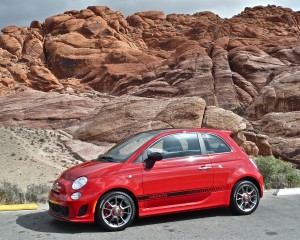

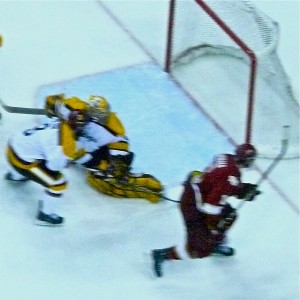
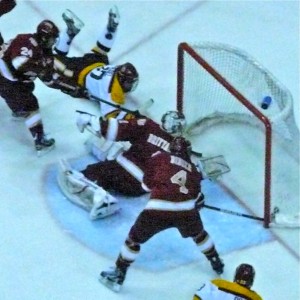
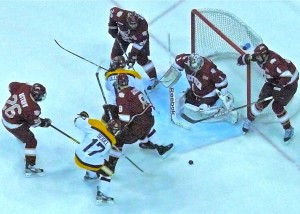
 John Gilbert is a lifetime Minnesotan and career journalist, specializing in cars and sports during and since spending 30 years at the Minneapolis Tribune, now the Star Tribune. More recently, he has continued translating the high-tech world of autos and sharing his passionate insights as a freelance writer/photographer/broadcaster. A member of the prestigious North American Car and Truck of the Year jury since 1993. John can be heard Monday-Friday from 9-11am on 610 KDAL(www.kdal610.com) on the "John Gilbert Show," and writes a column in the Duluth Reader.
John Gilbert is a lifetime Minnesotan and career journalist, specializing in cars and sports during and since spending 30 years at the Minneapolis Tribune, now the Star Tribune. More recently, he has continued translating the high-tech world of autos and sharing his passionate insights as a freelance writer/photographer/broadcaster. A member of the prestigious North American Car and Truck of the Year jury since 1993. John can be heard Monday-Friday from 9-11am on 610 KDAL(www.kdal610.com) on the "John Gilbert Show," and writes a column in the Duluth Reader.